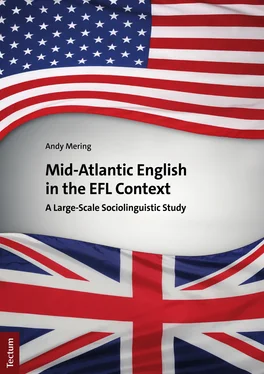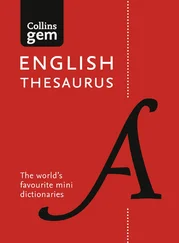Have Swedish university students adopted BrE or AmE pronunciation? What are their attitudes to it?
Another empirically relevant questionnaire-based study on the coexistence of BrE and AmE was undertaken by Axelsson-Westergren in 2000 (Modiano, 2002, pp. 132–146). Her informants were Swedish first-term university students of English studies from the Uppsala University. Her short study consisted of two parts: research into university students’ pronunciation and “the attitudes to her/his own pronunciation and the type of pronunciation s/he prefers” (2002, p. 133). Her survey participants had to read a short text aloud, which was recorded for purposes of analysis (2002, p. 135). The text contained words with six monitored phonemes that distinguish BrE from AmE. Axelsson-Westergren’s study revealed that 70 % of the surveyed students mixed phonological features from BrE and AmE, although only 36 % had professed to do so in their self-reports (2002, p. 144). Another interesting finding of her study is related to the most influencing factors for the English variety students speak. Eighty per cent of her informant group stated that television and film were the strongest factor that had an impact on their pronunciation, whilst school was only the third strongest. Supported by her statistical results, Axelsson-Westergren in the end draws the inescapable conclusion that a “one-accent approach” is not the best educational standard in Sweden and as a result, claims that EFL practitioners would be advised to acknowledge a combination of the two main varieties. In this way, students will be armed with a good communication strategy for global settings (2002, p. 144). Notwithstanding this sociolinguistically revealing outcome, some of Axelsson-Westergren’s chosen phonological variables are disputable.
First and foremost, the scholar’s choice of variables related to medial-t voicing in AmE vs its voiceless stop variant in BrE will be addressed. To this effect, she decided on the lexical items ‘communicated’ and ‘interchange’. Other variables such as ‘letter’ and ’better’, for example, with which university students are more familiar and which have a higher degree of frequency of use, would probably have offered higher research potential. It is also relevant to question the tested phonological item ‘fault’. The vowel of this noun is usually pronounced in BrE as /ɔː/ and in AmE, both as /ɑː/ and /ɔː/ (Jones, 2011, p. 183; Wells, 2008, p. 300). ‘Thought’, for example, would have been a more appropriate variable to monitor BrE/AmE phonological contrastiveness. Besides, it is important to point out that stress patterns were not accounted for in Axelsson-Westergren’s survey. This would have represented an added value to her research purpose of empirically ascertaining students’ alleged variety-switching between BrE and AmE, which would have consequently built up a more accurate sociolinguistic picture.
What is prospective German EFL Teachers’ actual linguistic behaviour towards BrE and AmE?
Within the framework of a Bachelor thesis, the primary focus of Jungert’s sociolinguistic online survey was on future German EFL teachers’ degree of blending of BrE and AmE features. His research was based on the four language areas of lexis, pronunciation, lexico-grammar, and spelling.
Jungert pursued his research in November 2011 in Germany, at the University of Education, Freiburg. His target group consisted of students of English studies. These students are trained either as primary or secondary school teachers and for this reason will play a key role as a linguistic model for their future school students, whose speech patterns will inevitably be influenced by them. Fifty students participated in Jungert’s study. They were recruited randomly on campus, which is why the questionnaire was short. It was divided into three parts. The first part consisted of 12 sentences with some selected monitored segmental and supra-segmental features pertaining to BrE and AmE. Survey participants had to read them aloud while they were being recorded. The second part was devised in German and asked questions on informants’ personal data, language contact, and the use of English media. The last part was in English and intended to determine university students’ lexical, grammatical, and orthographic use of either BrE or AmE. As for the lexical questionnaire component, it contained a lexical elicitation task with a set of different pictures in which students were required to describe each concept with a single word, to find out if they prefer the BrE or AmE lexical item. Furthermore, the author included four German words to be translated into English, either by the BrE or AmE word, depending on informants’ preference. Two sentences with three monitored variables were given to ascertain whether students employ BrE or AmE lexico-grammatical items.
Concerning Jungert’s pronunciation component of his questionnaire-survey, he could establish that the overall use of BrE and AmE features are, in his words, “absolutely balanced with a 50 % usage each. Thus, from a general point of view, there is no noticeable preference to any of the two varieties” (2011, p. 40). Moreover, Jungert established that the impact of media on students’ English played an important role. Fifty-six per cent of them claim that the media they use are both in BrE and AmE. Jungert also points to the fact that the consumption of AmE media clearly predominates among his informant group.
Jungert’s questionnaire-survey also demonstrated that in the area of lexis, a clear trend towards blending both varieties could be identified, with a marked preference for AmE. As to spelling, mixing occurred as well, but with a tendency towards BrE. Jungert provided a possible explanation for this outcome: the major part of his informant group learnt English in the mid-late 1990s when the educational standard was still mostly under the impact of BrE. It has continued to influence students’ spelling habits to date but they are increasingly also under the impact of AmE. Nevertheless, the investigation into students’ preferred use of lexico-grammatical items displayed a strikingly different picture. The overwhelming majority of the future English teachers opted for the BrE lexico-grammatical item, “almost ignoring the AE possibility” (2011, p. 57). Jungert surmises that this might be due to students usually acquiring lexico-grammar in institutionalised settings with primary focus on BrE.
From his empirical research into the variety status of trainee NNS English teachers, the researcher draws the overall conclusion that there is a considerable tendency towards a ‘MAE’ usage in the language areas of lexis, pronunciation, and spelling. Lexico-grammar, nonetheless, reflected a “stable preference” for BrE (2011, p. 58). In this connection, however, it must be objected that Jungert’s assertion of “stable preference” is only based on three monitored lexico-grammatical variables. A broader array of monitored lexico-grammatical items would have produced more conclusive evidence to determine if EFL university students’ lexico-grammatical usage is truly a matter of “stable preference”. In addition, Jungert’s survey could have afforded more sufficient empirical substantiation by integrating more variables into his survey. It must, of course, be conceded that within the framework of a Bachelor’s thesis the research scope is inevitably rather limited.
Overall, Jungert made a fine contribution to the changing sociolinguistic profile of university students of English studies by proving that their hybrid usage of BrE and AmE held up under closer empirical study within the framework of a Bachelor’s thesis.
2.6 A Novel Perspective in ELT
2.6.1 Paradigm Shift
Previous research has shown that today’s EFL constituency is unavoidably exposed to AmE through the entertainment media, advertisements, fashion, etc. It is a fact that Hollywood retains its dominance over the world market for cultural products like television and films. The European Audiovisual Observatory indicated that the market share of American films in 2000 was even on the rise in fifteen EU countries. Needless to say, the Internet, digital gaming, either online or stand-alone, radio, and print media also prove to be immensely rich in opportunities for the EFL community to have contact with English, often the American version (cf. Berns, 2007, pp. 30–35). This accounts for the sociolinguistic fact that EFL students also get their English input outside the classroom. This extramural English of informal domains was labelled by Preisler as “English from below” (1999, p. 247), which even results in a high motivation for young people to make use of English instead of their mother tongue. Hence, young European learners of English often harbour a genuine desire to foster peer group solidarity, whereby “code-switching to English is an inherent aspect of adolescent speech” (Preisler, 1999, p. 247). The intramural English that Europeans typically acquire in formal settings is called “English from above” by Preisler (1999, p. 247).
Читать дальше












